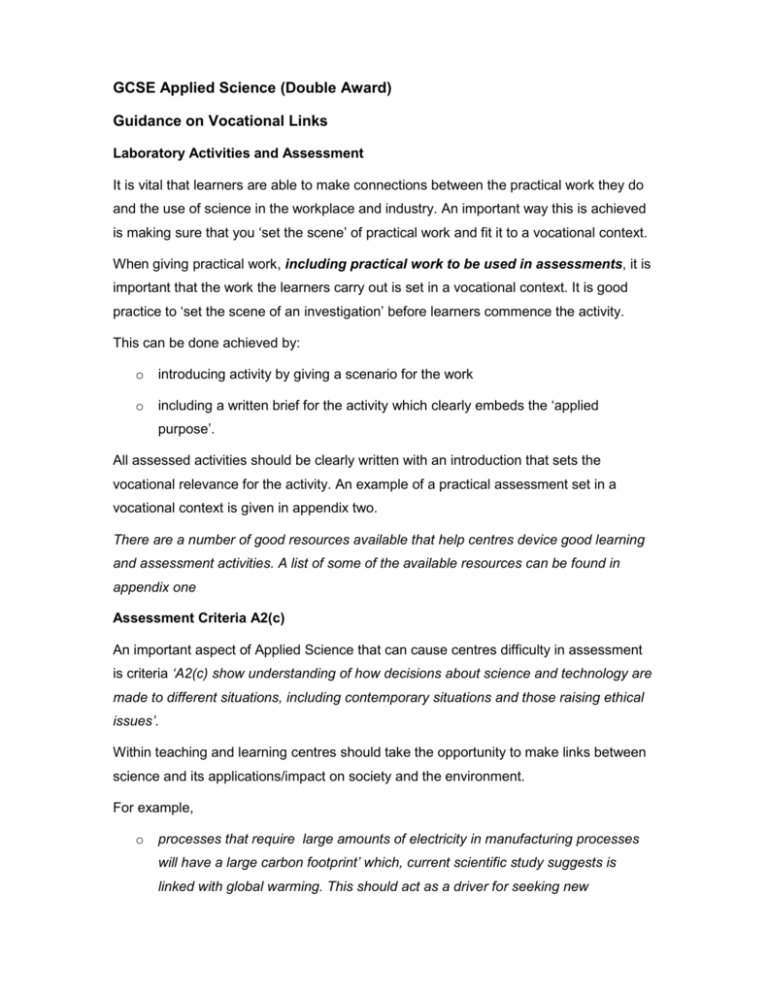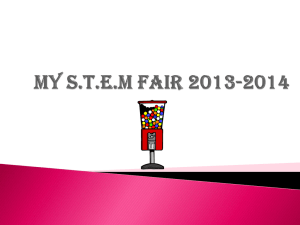Determination of Citric Acid in Bubble Gum
advertisement

GCSE Applied Science (Double Award) Guidance on Vocational Links Laboratory Activities and Assessment It is vital that learners are able to make connections between the practical work they do and the use of science in the workplace and industry. An important way this is achieved is making sure that you ‘set the scene’ of practical work and fit it to a vocational context. When giving practical work, including practical work to be used in assessments, it is important that the work the learners carry out is set in a vocational context. It is good practice to ‘set the scene of an investigation’ before learners commence the activity. This can be done achieved by: o introducing activity by giving a scenario for the work o including a written brief for the activity which clearly embeds the ‘applied purpose’. All assessed activities should be clearly written with an introduction that sets the vocational relevance for the activity. An example of a practical assessment set in a vocational context is given in appendix two. There are a number of good resources available that help centres device good learning and assessment activities. A list of some of the available resources can be found in appendix one Assessment Criteria A2(c) An important aspect of Applied Science that can cause centres difficulty in assessment is criteria ‘A2(c) show understanding of how decisions about science and technology are made to different situations, including contemporary situations and those raising ethical issues’. Within teaching and learning centres should take the opportunity to make links between science and its applications/impact on society and the environment. For example, o processes that require large amounts of electricity in manufacturing processes will have a large carbon footprint’ which, current scientific study suggests is linked with global warming. This should act as a driver for seeking new manufacturing processes which require lower energy consumption or alternative non-carbon based energy sources. o DNA testing as lead to a number of ethical questions concerning police databases, screening for disease etc o Medical research may use animals. There are ethical arguments on both sides of the debate that could be explored. This assessment criterion should be assessed under the criteria for W1c, W2c and W3c. (unit 3 ‘a report describing the work of scientists and how science is important in a wide variety of jobs’). Making Vocational Links The following are suggestions may help you improve the vocational links of your course. 1. Arrange for visits to local employers who use science. 2. Arrange for local practitioners of science to speak to your learners. 3. Provide a learning activity at the organisation’s premises. Learners may be able to observe the use of equipment that is not available at your school. This could be used to support the vocational context of a practical investigation in Unit 3. Examples may include: o the detection of micro organisms and use of microscopy – in a pathology laboratory or hospital; o chemical analysis – purity of substances, detection of pollutants, water purity; o investigating materials – types of materials used in the construction industry and how their properties fit them for purpose; o micro organisms – in the production of beer, yoghurt or bread. 4. Provide work experience as part of the planned school programme to the support the GCSE Applied Science course. Students will need guidance on selecting suitable placements that will provide support their learning. Employers will need to approve the tasks that students are expected to complete. 5. Improve the vocational context of the course by using local resources directly available to school. For instance your school could link to the following: o Education Business Partnerships; o Sectors such as Health, Fire, Police; o The Connexions; o Contacts that members of staff at your school may have; o Local Chamber of Commerce; o Further education colleges and other schools; o Local Universities, particularly those than run ‘applied’ courses such as Forensic Science, Medical Sciences. Appendix One: Resources Resources for investigations with a vocational/ Applied purpose can be found at: GCSE Applied Science Texts: Folens GCSE Applied Science Support Pack ISBN: 9781843039723 Author: Colin Bell, David Brodie, Byron Dawson, Ann Tiernan. Publisher: Folens TGAU Gwyddoniaeth Gymhwysol ISBN 978-1-905617-74-6 Author: Colin Bell, David Brodie, Byron Dawson, Ann Tiernan. Publisher: UWIC Press AQA Science: GCSE Applied Science Teacher's Book ISBN: 978-0-7487-9658-8 Author: Gerry Blake, Jo Locke. Editor: Lawrie Ryan Publisher: Nelson Thomes AQA Science: GCSE Applied science Student’s Book ISBN: 0748796576 Author: Gerry Blake, David Brown, James Hayward, Jo Locke, Kevin Ward. Editor: Lawrie Ryan Publisher: Nelson Thomes Websites Royal Society of Chemistry ‘Standard Procedures for GCSE Applied Science’ URL: http://www.rsc.org/education/teachers/learnnet/StandProcGCSE.htm British Standards Institute – Many suitable practicals for unit 1 http://www.bsieducation.org/Education/14-19/topic-areas/applied-science/default.shtml Microscopy and micro-organisms www.microbeworld.org gcsEASE http://channel4learning.com/sites/gcsease British Sugar www.britishsugar.co.uk/RVEb68fda6066794940a00bbc77675353a8,,.aspx Webucate http://www.webucate.org/ourgallery/thumbnails.php?album=73 SEP (Science Enhancement Programme) www.sep.org.uk Register with them to obtain very helpful free resources which contains practical work which could be adapted for Applied Science Appendix Two: Sample Investigation Determination of Citric Acid in Bubble Gum Teacher Guidance This investigation can be used with unit 1 of the GCSE Applied Science. Available Marks for this Investigation P1a, P1b P2a, P2b P3a, Not suitable for 4th band O1a, O1b O2a, O2b O3a Not suitable for 4th band A1 A2 A3a, A3b Not suitable for 4th band E1 E2 E2a E2b Not suitable for 4th band The method described is based on an analytical procedure used by the manufacturer of Bubba bubble gum. It could be easily adapted to test other products. Please ensure that a risk assessment is completed before learners undertake the activity. Determination of Citric Acid in Bubble Gum Background Citric acid (is added to food products to give them a sharp, acidic taste. It’s used, for example, to flavour Awesome Orange (“It's an orange attack! Let your mouth go wild with this awesome flavour”) Hubba Bubba bubble gum. The method described here is based on an analytical procedure used by the manufacturer of Bubba bubble gum. Setting the Scene An important aspect of quality control is ensuring that bubble gum contains the right amount of citric acid. In this analysis, you are carrying out the work of a technician who is using a standard procedure to determine the amount of citric acid in bubble gum. This procedure is carried out by technicians as part of the quality control on the product that is produced. Reagents 0.100 mol dm-3 sodium hydroxide solution Phenolphthalein indicator solution (0.2% in ethanol) Apparatus Kitchen rolling pin 250 cm3 conical flask 250 cm3 graduated flask 100 cm3 graduated flask Magnetic stirrer and follower 10 cm3 burette reading to nearest 0.02 cm3 with clamp, stand and white tile Top pan analytical balance reading to two decimal places. Health and Safety Risk Assessment Refer to Hazcards and decide on suitable relevant protection methods. Procedure Take one piece of orange flavoured Hubba Bubba bubble gum, unwrap it and place on a wood block. With a kitchen rolling pin, roll the gum into a very thin strip approx. 160 x 30 x 0.5 mm. Cut the thin strip into small pieces about the size of long grain rice. Weigh out 1.00 g of gum bits into a 250cm3 conical flask. Pour 100 cm3 of distilled water into the flask. Add a magnetic follower and stopper. Stir vigorously for 30 minutes making sure the bubble gum bits do not stick together. Add 0.5 cm3 of phenolphthalein indicator solution and titrate with 0.1 mol dm-3 sodium hydroxide contained in a 10 cm3 burette. The end-point is when a pink colour appears and remains after 15 seconds. Record the titre. Repeat twice more and average all three results. Make sure that you record your results in a suitable table. Calculations Calculate the average titration (t cm3) for the three samples analysed. Use the following formula to calculate the mass of citric acid monohydrate, in milligrams, in 100 g of the Hubba Bubba bubble gum: Mass of citric acid monohydrate in 100 g of gum = t x 0.71 g Collect the results (citric acid per 100g) of five other learners for different gums and record in a suitable table. Show this information as a suitable graph (amount citric acid v name analyst) Analysis Write an analysis of your work. Evaluate Evaluate your investigation. You should comment both on the procedure and your results. Describe how you could improve the results --------------------------------------------------------------------------------------




